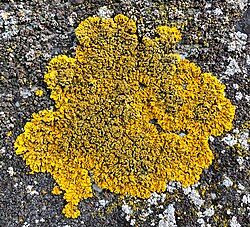Biology:Xanthoria calcicola
| Xanthoria calcicola | |
|---|---|

| |
| Scientific classification | |
| Domain: | Eukaryota |
| Kingdom: | Fungi |
| Division: | Ascomycota |
| Class: | Lecanoromycetes |
| Order: | Teloschistales |
| Family: | Teloschistaceae |
| Genus: | Xanthoria |
| Species: | X. calcicola
|
| Binomial name | |
| Xanthoria calcicola Oxner (1937)
| |
| Synonyms[1] | |
| |
Xanthoria calcicola is a species of saxicolous and corticolous (rock- and bark-dwelling), crustose lichen in the family Teloschistaceae.[2]
Taxonomy
The lichen was formally described as a new species in 1937 by the Ukrainian lichenologist Alfred Oxner.[3] Molecular analysis published in 1998 confirmed the genetic distinctiveness between Xanthoria calcicola and Xanthoria parietina.[4]
Distribution
Xanthoria calcicola is found in the southern temperate region of Europe, with its distribution range stretching from southern Scandinavia south to the Mediterranean Basin. Its presence extends eastward from Great Britain, reaching as far as Ukraine and various regions in the Middle East. The lichen grows primarily on stone, but is also frequently found growing on bark. A study conducted in Sweden found that X. calcicola typically does not prefer trees as habitats and only colonises them when they are in close proximity to an existing population on a wall.[5]
Species interactions
Several species of lichenicolous (lichen-dwelling) fungi are known to parasitise Xanthoria calcicola, including: Didymocyrtis slaptoensis, Pyrenochaeta xanthoriae, Didymocyrtis cf. consimilis, Erythricium aurantiacum, and Illosporiopsis christiansenii.[6]
Biomonitoring
A 2016 study investigated the metal and metalloid content in Xanthoria calcicola collected from the Syracusan petrochemical complex in Sicily, revealing high concentrations of elements like arsenic, chromium, nickel, and vanadium, indicative of environmental stress in the area. The use of multi-element statistical analysis and enrichment factors in the study demonstrated the effectiveness of Xanthoria calcicola as a bioindicator in highly industrialized environments, suggesting its potential application as a bioindicator in other industrial contexts.[7]
References
- ↑ "Synonymy. Current Name: Xanthoria calcicola Oxner, Viznachnilk Lishainikiv: 302 (1937)". Species Fungorum. https://www.speciesfungorum.org/Names/SynSpecies.asp?RecordID=371918.
- ↑ "Xanthoria calcicola Oxner". Species 2000: Naturalis, Leiden, the Netherlands. https://www.catalogueoflife.org/data/taxon/5C857.
- ↑ Oxner, A.N. (1937) (in ru). Viznachvik lishainikiv URSR (Forteckning over ukrainska sovjetrepublikens lavar). Kiev: Akademija Nauk Ukrainskoi RSR Institut Botaniki. p. 302.
- ↑ Franc, Niklas; Kärnefelt, Ingvar (1998). "Phylogeny of Xanthoria calcicola and X. parietina, based on rDNA ITS sequences". Graphis Scripta 9 (2): 49–54. https://nhm2.uio.no/botanisk/lav/Graphis/GS_9-2.pdf.
- ↑ Lindblom, Louise; Blom, Hans H. (2016). "Xanthoria calcicola (Teloschistaceae, Ascomycota) still present on bark in Sweden". Lindbergia 4: 41–45. doi:10.25227/linbg.01086.
- ↑ Kondratyuk, Serhii Y.; Suija, Ave; Kärnefelt, Ingvar; Thell, Arne (2023). "Lichenicolous fungi of southern Scandinavia with particular reference to those associated with Xanthoria calcicola s. lat.". Folia Cryptogamica Estonica 60: 129–136. doi:10.12697/fce.2023.60.12.
- ↑ Varrica, Daniela; Lo Medico, Federica; Alaimo, Maria Grazia (2022). "Air quality assessment by the determination of trace elements in lichens (Xanthoria calcicola) in an industrial area (Sicily, Italy)". International Journal of Environmental Research and Public Health 19 (15): e9746. doi:10.3390/ijerph19159746. PMID 35955102.
Wikidata ☰ Q10542676 entry
 |

